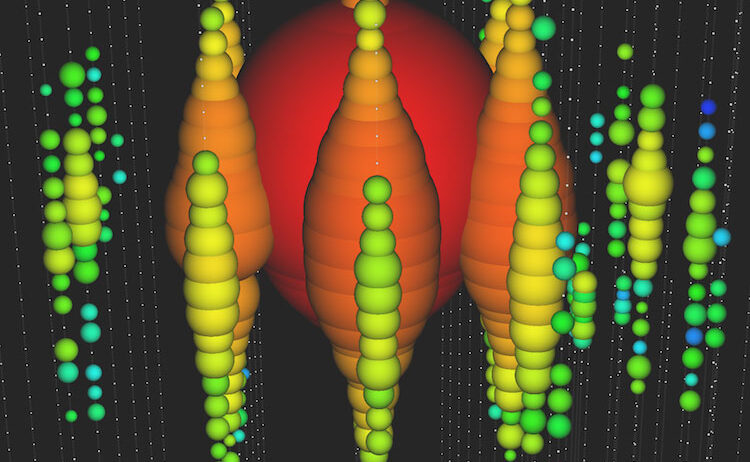In the intricate tapestry of the universe, neutrinos emerge as enigmatic messengers, darting through the cosmos almost undetected. These elusive particles, often referred to as “ghost particles,” play a pivotal role in the cosmos’s energy dynamics, prompting a perennial question: Do neutrinos conserve energy? Kirk McDonald, a prominent figure in the field of particle physics, provides a thought-provoking perspective that invites us to explore this question deeply.
At first glance, neutrinos may seem inconsequential, mere ephemeral wisps that traverse the vast expanses of space. Yet, their impact reverberates through the fundamental laws of physics. Neutrinos are born from cataclysmic events in the universe, such as supernovae and the collisions of cosmic rays. They carry energy and momentum, becoming vital components in the energy conservation equation that governs particle interactions. McDonald elucidates that while neutrinos are nearly massless, their ability to interact, albeit weakly, with matter means they can influence energy dynamics in profound ways.
To appreciate the conservation aspect, one must first comprehend the principle of energy conservation itself. This principle posits that energy cannot be created or destroyed; rather, it transforms from one form to another. In the universe’s grand performance, neutrinos often take center stage, facilitating the transfer of energy during nuclear reactions. For instance, during beta decay, an unstable atomic nucleus emits a neutrino, alongside an electron, effectively carrying away energy that was once contained within the nucleus.
This process parallels a skilled magician pulling a handkerchief from a seemingly empty hat, revealing that the energy was there all along, just cleverly concealed. In this analogy, the neutrinos serve as the magician’s assistant, quietly orchestrating the energy transformation. McDonald posits that understanding this role could unlock further insights into the universe’s energy balance and the origins of high-energy phenomena.
Furthermore, the study of neutrinos enriches our understanding of energy conservation on a cosmic scale. The energetic neutrinos detected from distant astrophysical sources provide a window into processes that occur billions of years ago. They act like ancient travel logs, chronicling the historical sum of energy interactions within their originating events. When high-energy neutrinos strike Earth, they offer clues to the most energetic processes in the universe, such as those found in gamma-ray bursts or active galactic nuclei.
Add to this the fascinating interplay between energy conservation and relativity, particularly in regards to neutrinos. As particles approach the speed of light, relativistic effects become significant. This velocity, paired with their minuscule mass, leads to intriguing implications for energy conservation in particle physics. Neutrinos are often produced in reactions that conserve energy and momentum, upholding fundamental physical laws while racing through space. The speed with which they travel might evoke the image of a dash of lightning slicing through a turbulent sky—swift, brilliant, and powerful.
One striking aspect of McDonald’s work is his emphasis on the unassuming nature of neutrinos. Despite being produced in massive quantities during stellar events, the overwhelming majority pass through matter without interaction. This reinforces the metaphor of the ghost particles, which traverse the fabric of space undisturbed, silently contributing to cosmic energy conservation. McDonald adeptly illustrates how this feature of neutrinos may symbolize unseen forces at play in our environment; much like the ambient energy of the Earth that goes unnoticed yet sustains life. Thus, the implication of conserving energy extends beyond the abstract confines of particle physics into environmental considerations that resonate with conservation efforts.
The challenges of capturing and studying neutrinos underscore the mysteries that persist in our quest for knowledge. Unlike more tangible particles, detection requires intricate setups, such as massive underground detectors filled with vibrant fluids. Such endeavors highlight the persistence and ingenuity of scientists striving to unravel the universe’s energy secrets. These sizable efforts mirror the endeavor to conserve our planetary energy resources. Both involve delving into unnoticed realms, harnessing insights that can lead towards a more sustainable future.
As humanity grapples with pressing concerns surrounding energy consumption and climate change, the significance of understanding particles like neutrinos cannot be overstated. Events that contribute to atmospheric neutrinos are paralleled by human-produced energy changes, introducing a broader context linking cosmic events to terrestrial challenges. By exploring how we can learn from neutrinos and their conservation of energy principles, we might uncover pathways to achieve efficient energy use—much like the cosmos itself achieves balance.
To conclude, neutrinos exemplify a journey between scientific inquiry and philosophical reflection on energy conservation. Kirk McDonald invites us into a world where the minute yet mighty neutrinos whisper the secrets of the universe, helping physicists decipher the language of energy transformation. The energy conservation embodied by neutrinos serves not just in theoretical physics but resonates profoundly in environmental advocacy. By recognizing the intricate connections between cosmic phenomena and everyday energy practices, one can envision a balanced future where humanity learns from the universe’s energy wisdom. In this pursuit, each neutrino becomes a beacon of hope for pristine energy stewardship, urging us to harness their lessons in our quest for sustainability.








